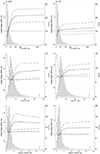Associations of Cardiac Biomarkers With Peripheral Artery Disease and Peripheral Neuropathy in US Adults Without Prevalent Cardiovascular Disease
- PMID: 37317848
- PMCID: PMC10526698
- DOI: 10.1161/ATVBAHA.122.318774
Associations of Cardiac Biomarkers With Peripheral Artery Disease and Peripheral Neuropathy in US Adults Without Prevalent Cardiovascular Disease
Abstract
Background: NT-proBNP (N-terminal pro-B-type natriuretic peptide), high-sensitivity cardiac troponin T (hs-troponin T), and high-sensitivity cardiac troponin I (hs-troponin I) are increasingly being recommended for risk stratification for a variety of cardiovascular outcomes. The aims of our study were to establish the prevalence and associations of elevated NT-proBNP, hs-troponin T, and hs-troponin I with lower extremity disease, including peripheral artery disease (PAD) and peripheral neuropathy (PN), in the US general adult population without known cardiovascular disease. We also assessed whether the combination of PAD or PN and elevated cardiac biomarkers was associated with an increased risk of all-cause and cardiovascular mortality.
Methods: We conducted a cross-sectional analysis of the associations of NT-proBNP, hs-troponin T, and hs-troponin I with PAD (based on ankle-brachial index <0.90) and PN (diagnosed by monofilament testing) in adult participants aged ≥40 years of age without prevalent cardiovascular disease in NHANES (National Health and Nutrition Examination Survey) 1999 to 2004. We calculated the prevalence of elevated cardiac biomarkers among adults with PAD and PN and used multivariable logistic regression to assess the associations of each cardiac biomarker, modeled using clinical cut points, with PAD and PN separately. We used multivariable Cox proportional hazards models to assess the adjusted associations of cross categories of clinical categories of each cardiac biomarker and PAD or PN with all-cause and cardiovascular mortality.
Results: In US adults aged ≥40 years, the prevalence (±SE) of PAD was 4.1±0.2% and the prevalence of PN was 12.0±0.5%. The prevalence of elevated NT-proBNP (≥125 ng/L), hs-troponin T (≥6 ng/L), and hs-troponin I (≥6 ng/L for men and ≥4 ng/L for women) was 54.0±3.4%, 73.9±3.5%, and 32.3±3.7%, respectively, among adults with PAD and 32.9±1.9%, 72.8±2.0%, and 22.7±1.9%, respectively, among adults with PN. There was a strong, graded association of higher clinical categories of NT-proBNP with PAD after adjusting for cardiovascular risk factors. Clinical categories of elevated hs-troponin T and hs-troponin I were strongly associated with PN in adjusted models. After a maximum follow-up of 21 years, elevated NT-proBNP, hs-troponin T, and hs-troponin I were each associated with all-cause and cardiovascular mortality, with higher risks of death observed among adults with elevated cardiac biomarkers plus PAD or PN compared with elevated biomarkers alone.
Conclusions: Our study establishes a high burden of subclinical cardiovascular disease defined by cardiac biomarkers in people with PAD or PN. Cardiac biomarkers provided prognostic information for mortality within and across PAD and PN status, supporting the use of these biomarkers for risk stratification among adults without prevalent cardiovascular disease.
Keywords: biomarkers; peripheral arterial disease; peripheral nervous system diseases; prevalence; prognosis; risk factors.
Conflict of interest statement
Figures


References
-
- Gerhard-Herman MD, Gornik HL, Barrett C, Barshes NR, Corriere MA, Drachman DE, Fleisher LA, Fowkes FGR, Hamburg NM, Kinlay S, et al. 2016 AHA/ACC Guideline on the Management of Patients With Lower Extremity Peripheral Artery Disease: Executive Summary: A Report of the American College of Cardiology/American Heart Association Task Force on Clinical Practice Guidelines. J Am Coll Cardiol. 2017;69:1465–1508. doi: 10.1016/j.jacc.2016.11.008 - DOI - PubMed
-
- American Diabetes Association Professional Practice C, American Diabetes Association Professional Practice C, Draznin B, Aroda VR, Bakris G, Benson G, Brown FM, Freeman R, Green J, Huang E, et al. 12. Retinopathy, Neuropathy, and Foot Care: Standards of Medical Care in Diabetes-2022. Diabetes Care. 2022;45:S185–S194. doi: 10.2337/dc22-S012 - DOI - PubMed
Publication types
MeSH terms
Substances
Grants and funding
LinkOut - more resources
Full Text Sources
Medical
Research Materials
Miscellaneous

